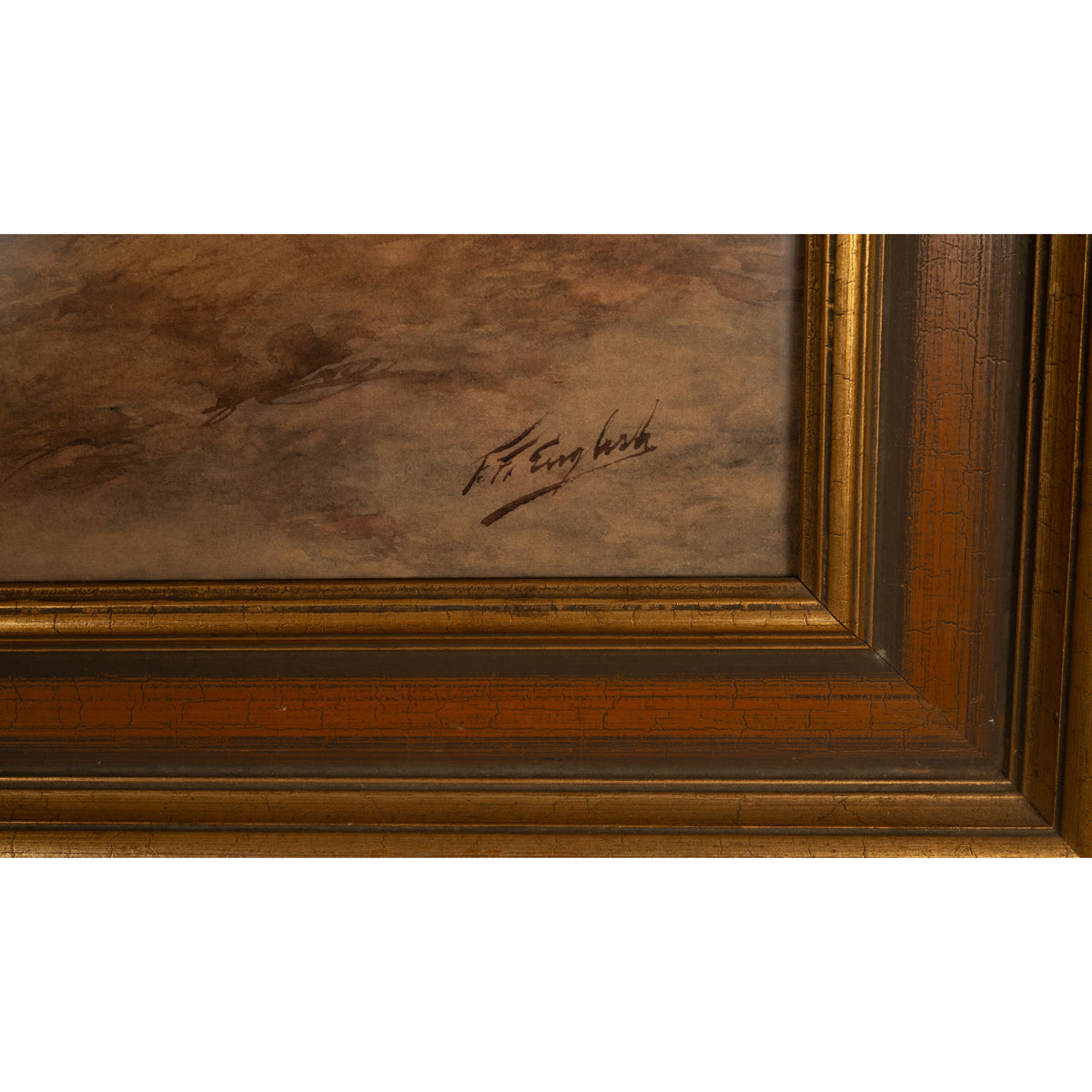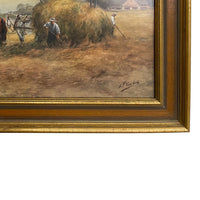Antique American Painting Bucks County Pennslyvania Harvest Landscape Scene Frank F. English 1900
- Regular
- $ 5,500
- Sale
- $ 5,500
- Regular
- Unit Price
- per
Antique American watercolor painting, landscape farm harvest scene by Frank F. English (1854 - 1922), Bucks County, Pennsylvania, Circa 1900.
A very attractive painting by the celebrated Pennsylvania artist Frank F. English, the location is in Point Pleasant, Bucks County, Pennsylvania. The painting depicts a scene of blue skies with two farmers tossing hay with pitchforks & two horses harnessed to a hay wagon, with barns to the background. The painting signed lower right " Frank F. English", condition is excellent and is ready to hang on your wall.
Frank F. English was born in Louisville Kentucky in 1854. In the early 1880s, he studied for five years in the evening classes of the Pennsylvania Academy of the Fine Arts. His instructors included Thomas Eakins, James P. Kelly and Thomas Anshutz.
However, English's reputation primarily rests with his outstanding facility as a watercolorist; most of his known paintings are executed in this medium. English's propensity for its use coincides, appropriately enough, with the watercolor's growing popularity among other American painters.
The American Water Color Society brought the medium special prominence by the late 1860s, and acceptance on the level of oil painting in 1876. That same year, the society was invited to display its works at the Philadelphia Centennial Exposition. Its members exhibited 116 watercolors, and their public exposure was enormous. It is safe to assume that during the 159-day Centennial, Frank English was among the nearly 10 million exposition attendees, surpassing attendance records at all preceding world's fairs.
At age twenty-two, English, traveled to Philadelphia to see works by the Society's notables such as Samuel Colman, R. Swain Gifford, Louis Comfort Tiffany, Albert Fitch Bellows, William Trost Richards, and James D. Smillie. Professional and popular acceptance of their pioneering efforts undoubtedly influenced English to adopt the medium as his primary artistic vehicle. Like fellow Philadelphian watercolorist Edmund Darch Lewis, English's prolific output brought lucrative results.
Amid growing regard by artists and the general public, English executed his watercolors with consummate skill and originality in handling; he set himself apart from contemporaries. English worked more loosely, incorporating broad and transparent washes of color strengthened by the judicious application of gouache.
English came from Louisville, Kentucky, but is more commonly associated with Claymont, Delaware, Philadelphia, and finally Point Pleasant, Bucks County, Pennsylvania, where he lived from about 1910 until his death in 1922. His earliest professional experiences were as an illustrator, contributing to newspapers, periodicals, and books.
The nineteenth-century witnessed enormous growth in public demand for illustrated books and periodicals. The American public developed an insatiable appetite for images of notable people and places, as well as the beauty of their country's natural scenery.
The artist took full advantage of the burgeoning industry, having his own bucolic images duplicated and disseminated in diverse ways. They were widely reproduced during his lifetime. Some, dating as early as 1892, were published by a variety of firms including J. Hoover & Sons, Philadelphia. These different prints numbered into the hundreds and were mass produced for calendars, advertisements, art prints, and store promotions. His art was also reproduced for post cards copyrighted by R. Hill in 1903 and published by Edward Stern & Co., Inc. of Philadelphia.
During the 1880s, he lived at various center-city locations in Philadelphia. At this same time, he attended the Pennsylvania Academy of the Fine Arts, received the finest instruction the country could offer, and learned from prominent artists such as Thomas Eakins, James Kelly, and Thomas Anshutz, another transplanted Kentuckian. English regularly participated in regional exhibitions.
Beginning in 1881, his name and painting titles are frequently listed among exhibition checklists. Records of his works can be found in shows held at the Pennsylvania Academy, the Art Club of Philadelphia, the American Water Color Society, The Plastic Club, the Art Institute of Chicago, and as far afield as the Pan-Pacific International Exposition in California.
English is, perhaps, most closely associated with the Philadelphia Sketch Club, the oldest American organization of its kind. The artist played an active role, serving in the Club's governance and instructional programs. He is memorialized by fellow member Thomas Anshutz, in one of many portraits Anshutz painted of early Sketch Club members, and arrayed in a frieze along the top of the Club's library.
English's years in Point Pleasant were some of his most productive; he is fondly and best remembered for his interpretations of Bucks County's rural character. He was part of the vanguard landscape tradition drawn by the area's natural beauty. He worked quietly on the outskirts of the art communities in New Hope and Phillips Mill. It seems he preferred painting alone and selling his works privately.
He painted breath-taking works in oil and some pastel paintings, but he excelled in capturing the countryside in watercolor; a medium which very few other artists were as successful or prolific in.
Frank F. English is best known for bucolic scenes of rural occupations and commutation: ploughmen with teams of horses, grazing cattle, blacksmith forges, cider making, harvesting chores, stage coaches, and horse drawn carriages. His works symbolize and preserve America cultural transition from an agrarian society. Like so many other nineteenth-century artists, he sought the pastoral environment, not only to escape urban realities, but to record the environment soon altered by expanding populations and technologies.
Landscape traditions are often a reaction to modernity and metropolitan expansion. While New York artists of the last century escaped to the Hudson River Valley, Philadelphia artists ventured up the Delaware River. English ultimately settled in rural Bucks County, capturing unique atmosphere, light, and terrain that attracted so many others. Perhaps English's ability to replicate, with aqueous medium, the drama of fluorescent sunsets or the brilliance of sun-parched summer days remain his greatest legacy
Imperial
ches high × ches wide × ches deep
Metric
high × wide x deep
Displayed rates are for shipping in the Continental U.S. and Canada. For other locations, kindly contact us and we will provide the most competitive shipping price available. All shipments are professionally packed and shipped insured with full tracking capabilities. Customers are also welcome to collect their items from our warehouses or arrange their own shipping.




























